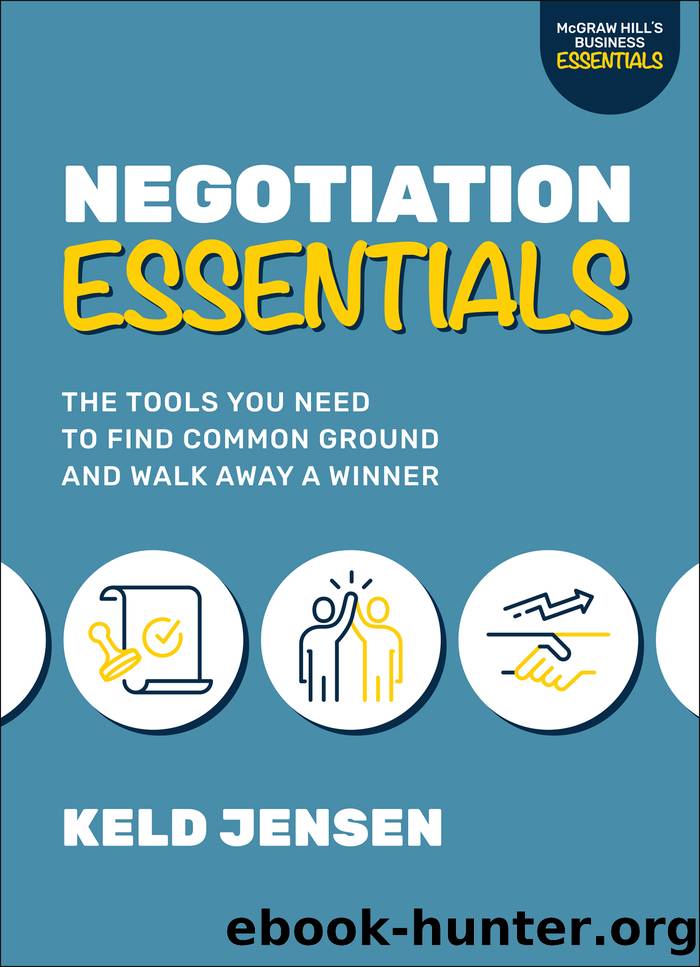Negotiation Essentials by Keld Jensen

Author:Keld Jensen
Language: eng
Format: epub
Publisher: McGraw Hill LLC
Published: 2024-04-15T00:00:00+00:00
PHASE 5: IDENTIFYING YOUR OPTIONS FOR NEGOTIATION
When two parties are deadlocked in a negotiation, one must concede some points in order to move forwardâa deadlock benefits no one. The negotiators must be more open to other ideas or specific in their arguments in order to achieve their desired outcome.
For example, a seller is offering 10,000 pounds of bricks at $10 per pound. You could say, âThatâs too expensive!â But making a counteroffer is a better idea: â$8.75 per pound is the maximum we can pay.â Now that the seller has a level to work from, he can glean a better understanding of how to proceed with negotiations.
An offer for $8.75 is $1.25 below what the seller is offering, since the original price of $10 is based on a consignment of 10,000 pounds. Letâs say the sellerâs threshold of pain is $9 per pound. What happens next? There are two potential solutions to this problem:
1. In order to keep the customer happy, the seller lowers his price.
The seller could make a unilateral compromiseâa compromise where there is no expectation of getting something in return. This transaction resembles those common in Turkish bazaars:
Seller: I think $9.75 is a good compromise.
Buyer: Those numbers arenât good enough; you can do better.
Seller: If you place your order today, I can reduce another 25 cents.
Buyer: There is a difference of 75 cents between my demand and your offer. Assuming that we split the difference, we come up with $9.10. Thatâs my best estimate.
Seller: Deal!
As you see, the seller didnât try to get more. In fact, the seller was very accommodating by offering another 25-cent reduction in a matter of minutes without first exploring alternatives. But the seller is still getting above the $9 per pound threshold of pain, so he is negotiating within his limits. That means he is not actually compromisingâin order to reach a genuine compromise, both parties would have to give up something, not just the seller. A situation like the one just described often involves counterbids to induce concessions from the other party.
Remember that opening offers are usually only the first offers used as a launching point to the true discussion. My extensive research reveals a general formula you can use to figure out the other negotiating partyâs true threshold of pain: divide the difference between the bids by two, divide that figure by two, and then subtract it from the original amount. So a negotiator who counters with $500 when you want $1,000 has a threshold of pain of $875:
Difference of $500/2 = $250, divided by 2 = $125 and $1,000 â $125 = $875
So knowing that, you could start with 1,000, counter their 500 offer with 955, then 875, and so on and so forth until you stop before their actual threshold number. The idea is to keep even figures to a minimum so you donât end up losing more than you should. Taking big leads in a negotiation only leaves room for more loss than gain. Reduce the percentage to 9.
Download
This site does not store any files on its server. We only index and link to content provided by other sites. Please contact the content providers to delete copyright contents if any and email us, we'll remove relevant links or contents immediately.
| Conflict Resolution & Mediation | Human Resources & Personnel Management |
| Knowledge Capital | Outsourcing |
Bullshit Jobs by David Graeber(4136)
Radical Candor by Kim Scott(2689)
I Am Right, You Are Wrong by Edward De Bono(2428)
23:27 by H. L. Roberts(2223)
Nomadland by Jessica Bruder(2036)
Average Is Over by Tyler Cowen(1823)
The Conflict Resolution Phrase Book by Barbara Mitchell & Cornelia Gamlem(1753)
Out of Our Minds: Learning to Be Creative by Ken Robinson(1720)
High-Impact Interview Questions by Victoria A. Hoevemeyer(1672)
Who Moved My Cheese?: An Amazing Way to Deal With Change in Your Work and in Your Life by Johnson Spencer(1626)
The Ideal Team Player by Patrick M. Lencioni(1619)
An Everyone Culture: Becoming a Deliberately Developmental Organization by Robert Kegan & Lisa Laskow Lahey(1617)
The Asshole Survival Guide by Robert I. Sutton(1577)
Automatic Society by Bernard Stiegler(1531)
Unleashed by Anne Morriss & Frances Frei(1512)
Who by Street Randy & Smart Geoff(1486)
42 Rules of Employee Engagement by Susan Stamm(1450)
96 Great Interview Questions to Ask Before You Hire by Paul Falcone(1434)
Fish! by Stephen C. Lundin(1375)
